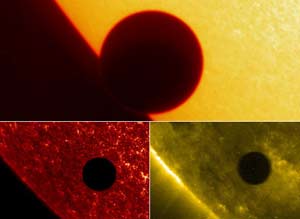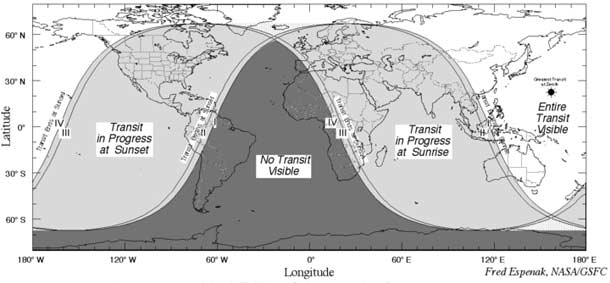Create a free profile to get unlimited access to exclusive videos, sweepstakes, and more!
Everything you need to know about next week's Transit of Venus

 On Tuesday/Wednesday June 5/6, Earth will have the best seat -- the only seat -- for a great show: the Transit of Venus across the face of the Sun. This is a relatively rare event, and the next one won't happen until December 10, 2117, so I'm guessing this will be the last time you'll be able to see it.
On Tuesday/Wednesday June 5/6, Earth will have the best seat -- the only seat -- for a great show: the Transit of Venus across the face of the Sun. This is a relatively rare event, and the next one won't happen until December 10, 2117, so I'm guessing this will be the last time you'll be able to see it.
I have a lot of info below, so I've broken it up into sections. Also, a special note: Fraser Cain, Pamela Gay, and I are hosting a live online video chat star party for the transit! That live video feed will be embedded here on the blog at the time of the transit, so if you read this blog -- and you do -- you'll see it. I'll have more info closer to the date.
Oh -- you can click on the pictures here to embiggen them and get more info, too.
Â
1) What Is the Transit?
2) Observing the Transit (incl. how to do so safely)
3) Watching Online
4) Resources
Â
What Is the Transit?
A transit is when one object in the sky passes in front of another. In this case, we'll see Venus move across the Sun's face. Think of it as a mini-eclipse.
 Venus orbits the Sun closer in than we do, taking about 225 days to circle it once. We don't see a transit every time, though, because its orbit is tilted slightly (by about 3°) to the Earth's, so most of the time it passes near the Sun, but misses it*. Only when the planets align just right do we see an actual transit.
Venus orbits the Sun closer in than we do, taking about 225 days to circle it once. We don't see a transit every time, though, because its orbit is tilted slightly (by about 3°) to the Earth's, so most of the time it passes near the Sun, but misses it*. Only when the planets align just right do we see an actual transit.
The geometry works out in a funny way. Transits come in pairs 8 years between events, but each pair is separated from the next two by more than a century. The last pair was 1874/1882. The next transit after that was in 2004. Now we have the second of our current pair, and then the next two won't be until 2117/2125!
I saw the last transit in 2004, and it was pretty awesome. Venus was just a small dot, barely a disk, seen in silhouette against the Sun, but it was clearly not a sunspot even without magnification. I'll note here you shouldn't observe the Sun without eye protection! I have more about that in the Observing the Transit section below.
Historically, the transit was used to measure the size of the solar system. In the 1600s, the distances to the planets were only known in units of the Earth's orbit. So Venus was 0.7 times as far from the Sun as Earth, and Jupiter was 5 times as far. But the actual size of Earth's orbit wasn't known! Before we had space probes and radar (which we can use to bounce signals off planets and measure their distance directly) it was hoped the transit of Venus would allow it to be measured. It worked, but the details are pretty cool and well worth a read. The story is actually told pretty well on the Wikipedia page.
Even in modern times, transits are useful. We look for planets orbiting other stars using a similar method, watching for a dip in the light as the planet blocks the star. To help refine this method, astronomers will use Hubble (!) to look at the Moon (!) -- since the Moon is lit by the Sun, the tiny drop in sunlight during the transit should dim the Moon a bit. They're actually hoping to see if they can detect Venus's atmosphere too, since that will affect how the light gets to the Moon from the Sun. Amazing.
Interestingly, as seen from Saturn in December 2012, Venus will transit the Sun as well, and astronomers are hoping to use Cassini to see if they can detect it. Also, in 2014, Earth will transit the Sun as seen from Jupiter! Hubble may be used to observe Jupiter at that time to see if it can be detected as well. [Thanks to BABloggee Garrett Curley for this info! You can read more about these space observations at Physics World - you have to register, but it's free.]
Â
*[Actually, because the Earth is moving around the Sun as well, after one complete orbit Venus still has to "catch up" to the Earth to line up with the Sun again. That's called the synodic period, and it takes about 584 days. Still, the tilt of Venus's orbit means it doesn't always cross the Sun directly every synodic orbit.]
Â
Â
So I wanna see it! What do I do?
Because Venus is transiting the Sun, it has to be daytime during the transit for you to see it (duh). The transit occurs from about 22:00 June 5 to 05:00 June 6 (UTC; subtract 4 hours for Eastern US time). The exact time depends on where you are on Earth; NASA has a list of times for US cities and for the rest of the world.
For a more general overview, here's a map of where the transit is visible:
Places in white see the whole event. Light grey areas see either the first part of the transit with the Sun setting during the event, or the last part of the transit because it's already in progress during sunrise. Areas in dark grey don't get to see it at all (sorry eastern South America and western Africa; but you can watch it online!). Since the transit ends at 01:00 Eastern US time, the Sun sets before the transit ends, and the farther west you go the more of the transit you'll see.
If you look, what will you see? The Sun is 115 times wider than Venus, but Venus is much closer to us than the Sun is (about 42 million km versus 150 million -- 25 versus 93 million miles). Because of that, Venus will look to be about 1/30th the Suns diameter, just big enough to see as a tiny disk by eye (but DON'T LOOK AT THE TRANSIT UNPROTECTED; see below).
 This is an illustrative animation of what the 7 hour transit will look like. The Sun probably will have sunspots visible during the transit, but Venus will be darker and rounder than they are.
This is an illustrative animation of what the 7 hour transit will look like. The Sun probably will have sunspots visible during the transit, but Venus will be darker and rounder than they are.
OBSERVING THE TRANSIT SAFELY IS INCREDIBLY IMPORTANT. While looking at the Sun won't necessarily cause permanent or total blindness, it's not a good idea, and you should NEVER look at the Sun through binoculars or a telescope unless they are outfitted properly. If you don't know what you're doing with astronomical equipment, the best bet is don't do it.
However, there are many ways to observe the transit safely. In fact, observing the transit is pretty much the same as observing a solar eclipse, so the same rules apply. I have a list and links on a post I wrote about the May 2012 solar eclipse. Basically, filtered glasses specifically designed for eclipses are good (not just sunglasses, and don't look through exposed film or mylar or anything like that unless again it's specifically designed for looking at the Sun). You can use binoculars or a telescope to project the light from the Sun onto a piece of paper (though you can damage your optics that way). You can build a pinhole projector, but unlike an eclipse the shadow of Venus is small and may be hard to see that way. A flat mirror covered with foil can be used to project the Sun as well -- this video shows you how. Again though the image may not be sharp enough to let you see Venus.
The safest way, of course, is to watch it online. The view's better, too. But still, there's nothing like seeing it with your own eyes. Just be careful if you do.
[Update: Sorry, I meant to include this originally: There are a few places online where you can search for local your astronomy club/society, like AstronomyClubs.com and Sky and Telescope's website.]
Â
How to watch the transit online
Below are links where you can watch the transit live online. My top suggestion is you watch our live video star party, where we'll have experts and live views through amateur telescopes across the planet. I'll embed the video stream on a new blog post at the date and time of the transit, or you can watch it on CosmoQuest. That will be hosted using Hangouts On Air on Google+. If you're signed up for G+, circle Fraser Cain to be able to participate in the chat room, too.
The more live webcasts there are, the better; it's likely to be cloudy in some spots, so you can try others to see if they have better weather. I'll update this list as more links come in.
- NASA
- NASA Edge
- University of Barcelona (from a telescope in Norway)
- National Solar Observatory
- San Francisco's Exploratorium (via the Mauna Loa Observatory)
- NASA TV
- Coca Cola Space Science Center (from Australia)
- Bareket observatory (Israel)
- Mt. Lemmon Sky Center
- Astronomers Without Borders (from Mt. Wilson, California)
Â
Resources
There are approximately eleventy bazillion websites with more info. Here are a few:
- Transit of Venus (.org)
- Transit of Venus (.nl)
- Wikipedia
- Astronomers Without Borders
- ESA
- NASA
- Astronomy magazine
- Sky and Telescope magazine
- Naval Observatory (PDF)
There are also some other interesting things going on with the transit:
Here's an interesting idea to crowd-source and do a live calculation of the distance from the Earth to the Sun using peoples' tweets! You can follow that effort on Twitter.
Check this out: there's even a comic book/graphic novel about the transit made in India and available in six languages (including English)! I gave it a once-over and it's very engaging and looks pretty accurate.
If you are observing the transit with a telescope, there's an interactive phone app that will allow you to time various parts of the transit, and which will collect the data into a repository and map it.
Â
That's it! Enjoy the transit! Remember, if you miss it, the next one won't be for 105 years. You might get to see it, but it won't be as much fun when you're a disembodied head in a jar. So grab this chance now.
Â
Image credits: NASA/LMSAL; IPS Radio and Space Services; Fred Espenak/NASA/GSFC; Marc van der Sluys
Â
Â
Â















